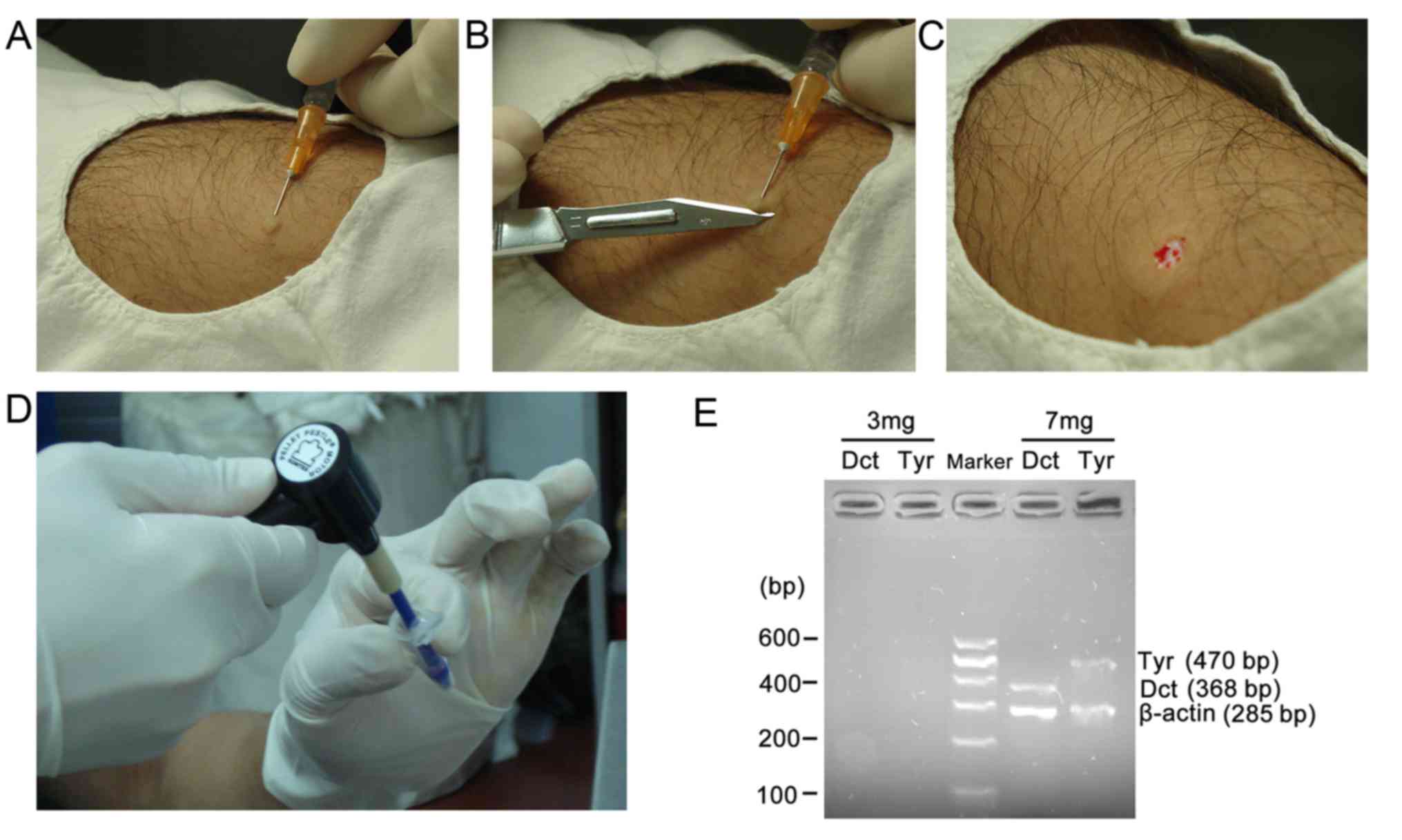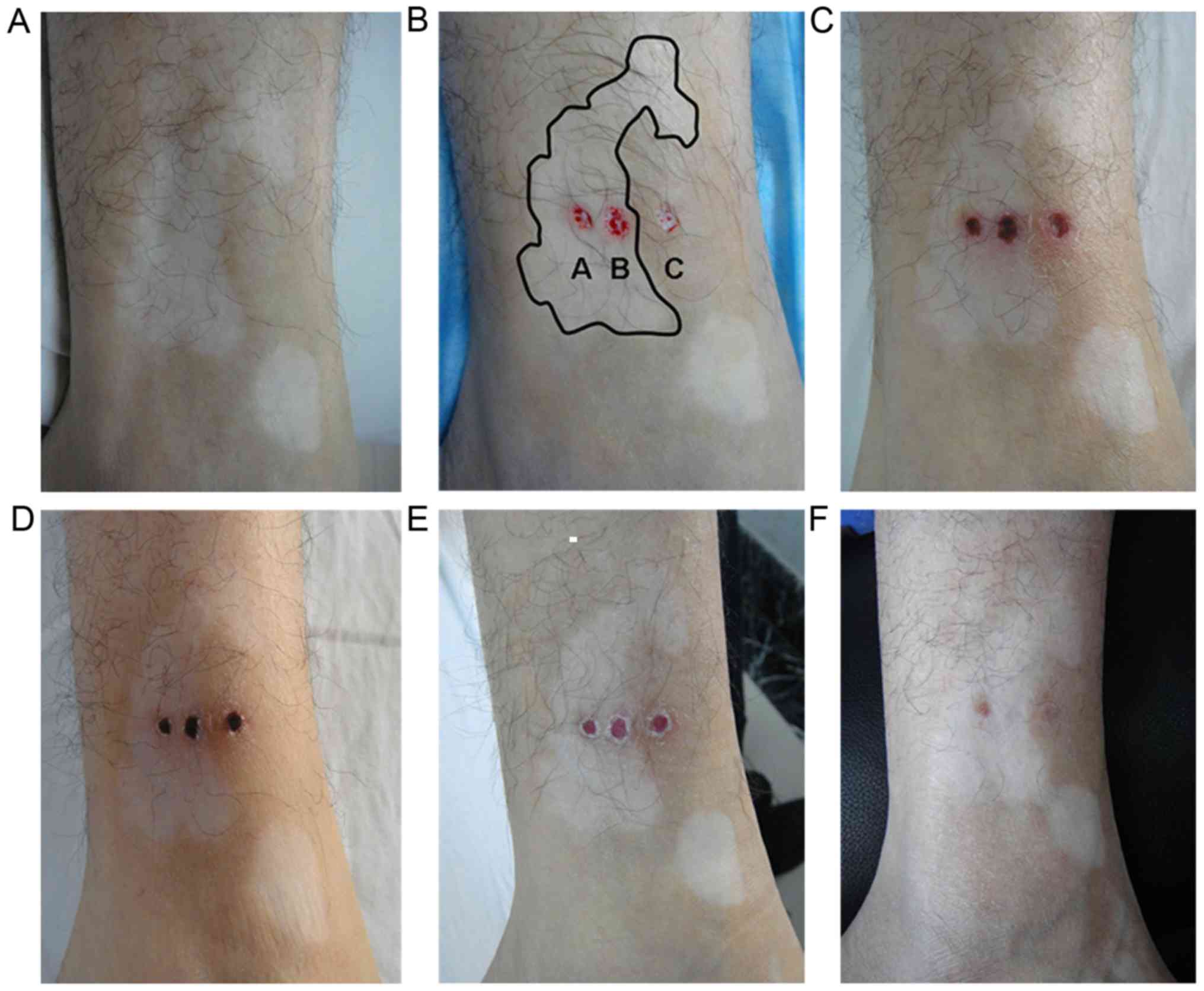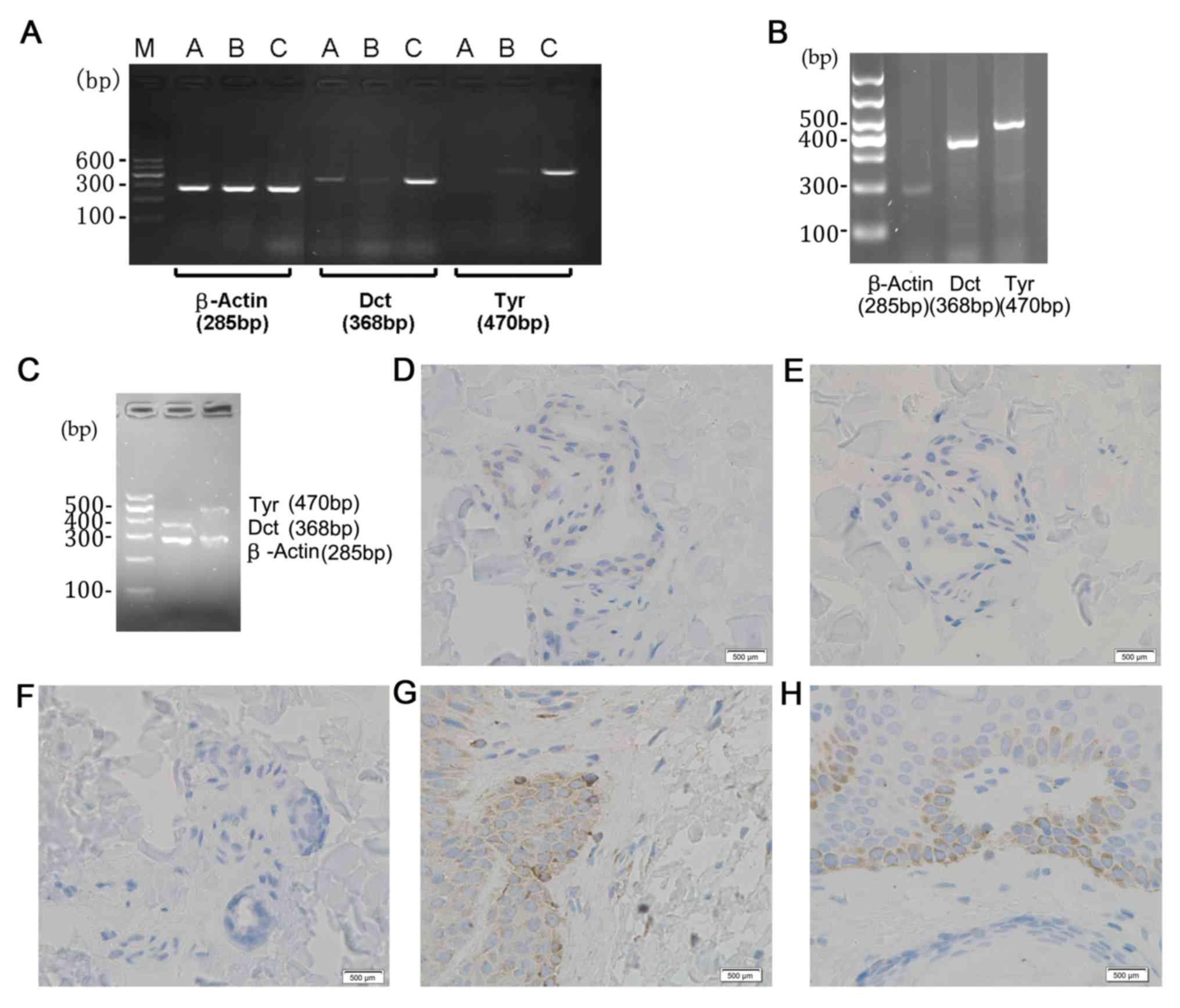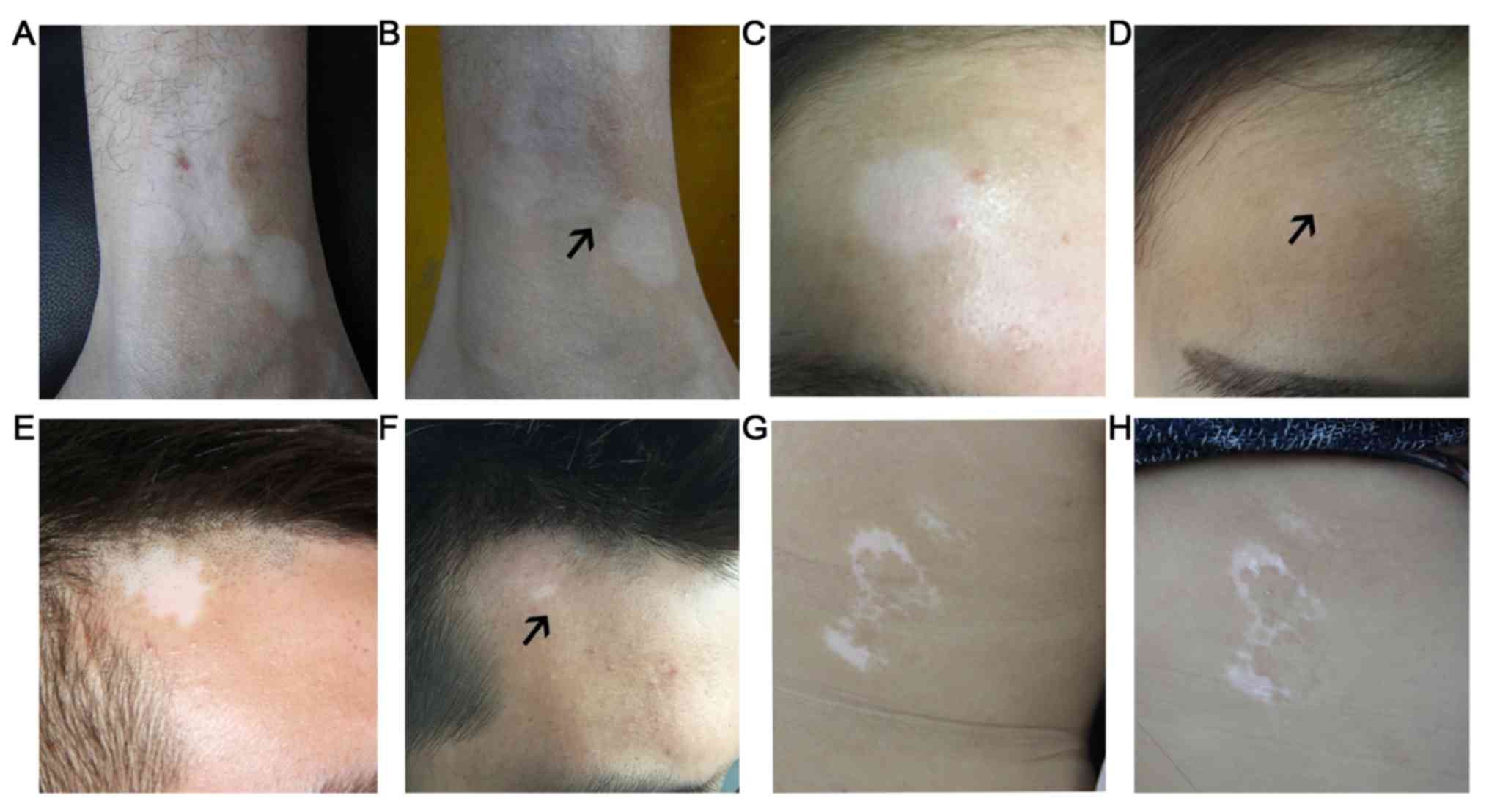|
1
|
Manga P, Elbuluk N and Orlow SJ: Recent
advances in understanding vitiligo. F1000Res. 5:F10002016.
View Article : Google Scholar : PubMed/NCBI
|
|
2
|
Bacigalupi RM, Postolova A and Davis RS:
Evidence-based, non-surgical treatments for vitiligo: A review. Am
J Clin Dermatol. 13:217–237. 2012. View Article : Google Scholar : PubMed/NCBI
|
|
3
|
Lai YC, Yew YW, Kennedy C and Schwartz RA:
Vitiligo and depression: A systematic review and meta-analysis of
observational studies. Br J Dermatol. 177:708–718. 2017. View Article : Google Scholar : PubMed/NCBI
|
|
4
|
Boniface K, Seneschal J, Taïeb A and
Merched A: Vitiligo therapy: Restoring immune privilege? Exp
Dermatol. 26:635–636. 2017. View Article : Google Scholar : PubMed/NCBI
|
|
5
|
Patel NS, Paghdal KV and Cohen GF:
Advanced treatment modalities for vitiligo. Dermatol Surg.
38:381–391. 2012. View Article : Google Scholar : PubMed/NCBI
|
|
6
|
Ghafourian A, Ghafourian S, Sadeghifard N,
Mohebi R, Shokoohini Y, Nezamoleslami S and Hamat RA: Vitiligo:
Symptoms, pathogenesis and treatment. Int J Immunopathol Pharmacol.
27:485–489. 2014. View Article : Google Scholar : PubMed/NCBI
|
|
7
|
Tsatmali M, Ancans J and Thody AJ:
Melanocyte function and its control by melanocortin peptides. J
Histochem Cytochem. 50:125–133. 2002. View Article : Google Scholar : PubMed/NCBI
|
|
8
|
Eskandani M, Golchai J, Pirooznia N and
Hasannia S: Oxidative stress level and tyrosinase activity in
vitiligo patients. Indian J Dermatol. 55:15–19. 2010. View Article : Google Scholar : PubMed/NCBI
|
|
9
|
Zhu PY, Yin WH, Wang MR, Dang YY and Ye
XY: Andrographolide suppresses melanin synthesis through
Akt/GSK3β/β-catenin signal pathway. J Dermatol Sci. 79:74–83. 2015.
View Article : Google Scholar : PubMed/NCBI
|
|
10
|
Nishimura EK, Jordan SA, Oshima H, Yoshida
H, Osawa M, Moriyama M, Jackson IJ, Barrandon Y, Miyachi Y and
Nishikawa S: Dominant role of the niche in melanocyte stem-cell
fate determination. Nature. 416:854–860. 2002. View Article : Google Scholar : PubMed/NCBI
|
|
11
|
Rodrigues M, Ezzedine K, Hamzavi I, Pandya
AG and Harris JE; Vitiligo Working Group, : Current and emerging
treatments for vitiligo. J Am Acad Dermatol. 77:17–29. 2017.
View Article : Google Scholar : PubMed/NCBI
|
|
12
|
Parsad D, Pandhi R, Dogra S and Kumar B:
Clinical study of repigmentation patterns with different treatment
modalities and their correlation with speed and stability of
repigmentation in 352 vitiliginous patches. J Am Acad Dermatol.
50:63–67. 2004. View Article : Google Scholar : PubMed/NCBI
|
|
13
|
Arrunátegui A, Arroyo C, Garcia L, Covelli
C, Escobar C, Carrascal E and Falabella R: Melanocyte reservoir in
vitiligo. Int J Dermatol. 33:484–487. 1994. View Article : Google Scholar : PubMed/NCBI
|
|
14
|
Liu XM, Zhou Q, Xu SZ, Wakamatsu K and Lei
TC: Maintenance of immune hyporesponsiveness to melanosomal
proteins by DHICA-mediated antioxidation: Possible implications for
autoimmune vitiligo. Free Radic Biol Med. 50:1177–1185. 2011.
View Article : Google Scholar : PubMed/NCBI
|
|
15
|
Jiang S, Liu XM, Dai X, Zhou Q, Lei TC,
Beermann F, Wakamatsu K and Xu SZ: Regulation of DHICA-mediated
antioxidation by dopachrome tautomerase: Implication for skin
photoprotection against UVA radiation. Free Radic Biol Med.
48:1144–1151. 2010. View Article : Google Scholar : PubMed/NCBI
|
|
16
|
Budania A, Parsad D, Kanwar AJ and Dogra
S: Comparison between autologous noncultured epidermal cell
suspension and suction blister epidermal grafting in stable
vitiligo: A randomized study. Br J Dermatol. 167:1295–1301. 2012.
View Article : Google Scholar : PubMed/NCBI
|
|
17
|
Maleki M, Banihashemi M and Sanjari V:
Efficacy of suction blister epidermal graft without phototherapy
for locally stable and resistant vitiligo. Indian J Dermatol.
57:282–284. 2012. View Article : Google Scholar : PubMed/NCBI
|
|
18
|
Botchkareva NV, Botchkarev VA and
Gilchrest BA: Fate of melanocytes during development of the hair
follicle pigmentary unit. J Investig Dermatol Symp Proc. 8:76–79.
2003. View Article : Google Scholar : PubMed/NCBI
|
|
19
|
Benzekri L, Ezzedine K and Gauthier Y:
Vitiligo potential repigmentation index: A simple clinical score
that might predict the ability of vitiligo lesions to repigment
under therapy. Br J Dermatol. 168:1143–1146. 2013. View Article : Google Scholar : PubMed/NCBI
|
|
20
|
Goldstein NB, Koster MI, Hoaglin LG,
Spoelstra NS, Kechris KJ, Robinson SE, Robinson WA, Roop DR, Norris
DA and Birlea SA: Narrow band ultraviolet B treatment for human
vitiligo is associated with proliferation, migration, and
differentiation of melanocyte precursors. J Invest Dermatol.
135:2068–2076. 2015. View Article : Google Scholar : PubMed/NCBI
|
|
21
|
Mou Y, Jiang X, Du Y and Xue L:
Intelligent bioengineering in vitiligo treatment: Transdermal
protein transduction of melanocyte-lineage-specific genes. Med
Hypotheses. 79:786–789. 2012. View Article : Google Scholar : PubMed/NCBI
|
|
22
|
Kawakami A and Fisher DE: The master role
of microphthalmia-associated transcription factor in melanocyte and
melanoma biology. Lab Invest. 97:649–656. 2017. View Article : Google Scholar : PubMed/NCBI
|
|
23
|
Guo J, Zhang JF, Wang WM, Cheung FW, Lu
YF, Ng CF, Kung HF and Liu WK: MicroRNA-218 inhibits melanogenesis
by directly suppressing microphthalmia-associated transcription
factor expression. RNA Biol. 11:732–741. 2014. View Article : Google Scholar : PubMed/NCBI
|
|
24
|
Cichorek M, Wachulska M, Stasiewicz A and
Tymińska A: Skin melanocytes: Biology and development. Postepy
Dermatol Alergol. 30:30–41. 2013. View Article : Google Scholar : PubMed/NCBI
|


















